Exponentials and logarithms
| © 2007 Rasmus ehf and Jóhann Ísak Pétursson |
Exponentials and logarithms |
Lesson 3
Natural logarithms
As calculators and computers have become the tools for most numerical operations, logarithms with the base 10 have become less useful. On the other hand a logarithm with another base than 10 has become increasingly useful in many of the sciences.
This function is called the Natural Logarithm function and has the symbol ln.
f(x)=ln x
The base for natural logarithms is a number e that you can see on your calculator.
e is an irrational number e![]() 2.718
2.718
| Example 1 |
 |
Here is how you find the natural logarithm of 2 on a CASIO-calculator:
![]()
The answer is approximately 0.693 which is the power that we need to raise e to in order to get 2.
e0.693 ≈ 2
Check this on you calculator:
![]()
The answer given is 1.9997 ≈ 2.
The functions f(x) = ln x and g(x) = ex cancel each other out when one function is used on the outcome of the other. This is the same as happens with f(x) = log x and g(x) = 10x or squaring a number then taking the square root of the outcome. In other words the function f(x) = ln x is the inverse of the function g(x) = ex.
The following is true: ln ex = x og eln x = x
The number e is irrational
and therefore we cannot find an exact value for it.
We can calculate it’s value to any number of decimal places by choosing bigger
and bigger values of x and putting them in the following formula.

Example 2
Calculate e by putting x = 1000 into the formula and using a calculator.

Using EXCEL we get the value 2.7182818284591 for e. So choosing x = 1000 only gives us two correct figures. Now try calculating e by using x = 1000000.

Now we have five correct figures. The higher the value of x the more the accuracy in our calculation of e.
Example 3
Draw the graphs of the functions f(x) = ln x and g(x) = ex.
First make a table of values:
| x | f(x) = ex | x | g(x) = ln x | |
| -3 | 0.05 | -1.39 | ||
| -2 | 0.14 | -0.69 | ||
| -1 | 0.37 | 1 | 0 | |
| 0 | 1 | 2 | 0.69 | |
| 1 | 2.72 | 4 | 1.39 | |
| 2 | 7.39 | 8 | 2.08 |
Notice there are no negative values in column for g(x) = ex and there are no negative valuesin the x column for the inverse function g(x) = ln x .
The Domain for f(x) = ln x is the set { xÎR | x > 0 }.
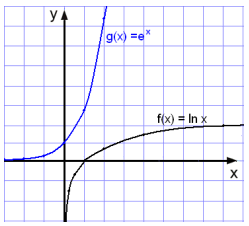
Notice that when we draw both graphs in the same
coordinate system they are the mirror image of each
other (symmetric) in a line drawn through the points where y = x.
This is true of the graphs of any two functions that are the inverse of each other.
The same rules hold for the natural logarithmic function
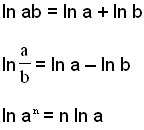
The following examples show how these rules are used .
Example 4
Solve the following equations :
a)
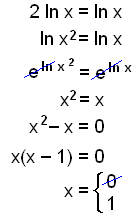 |
Move
the 2 and write as a power. Put in the base number e on both sides of the equation. e and ln cancel each other out leaving us with a quadratic equation. Move the x over the equals sign. Factorise and solve for x |
x = 0 is impossible as there is no way of writing 0 as a power.
b)
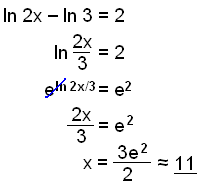 |
Write
the left side as one logarithm.
Put in the base number e. ln and e cancel each other out.
|
c)
|
|
Simplify the left by writing as one logarithm. |
|
|
Put in the base e on both sides. |
Example 5
Solve the following equations:
a)
 |
Take the logarithm of both sides. |
b)
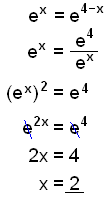 |
Use
the rules: (a n)m = a nm to write each side as a power of e.
|
c)
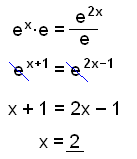 |
Use
the rules:
|
Example 6
Solve the equations:
a)
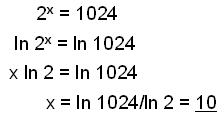 |
Take
the log of both sides of the equation then use the rule
|
b)
 |
Take
the terms in x to one side of the equation and other terms to the other
side. Simplify using the rules for indices.
|
c)
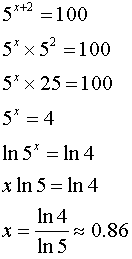 |
Separate the powers of 5. divide both sides by 25 then solve for x as before.
|
Try Quiz 3 on Exponentials and logarithms.
Remember to use the checklist to keep track of your work.